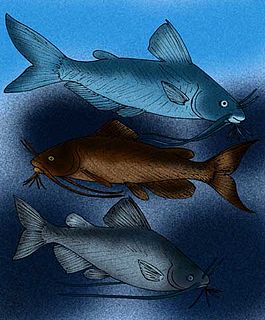 W
WAndinichthyidae is a prehistoric family of catfishes from the Cretaceous to Eocene of South America.
 W
WAntarctilamna is an extinct genus of Devonian shark originally exemplified by Antarctilamna prisca from South Eastern Australia and Antarctica. The latest occurring described species is Antarctilamna ultima from the Waterloo Farm lagerstätte in South Africa. Antarctilamna has robust ctenacanthid-like spines which lack a deep insertion area, and are borne in front of the first dorsal fin; in addition to distinctive diplodont teeth with small intermediate cusps. Antarctilamna-like spines, known from the Bunga Beds locality in Australia have been ascribed to A. Prisca.
 W
WArganodus is an extinct genus of Ceratodontidae (lungfish). Its fossils have been found in the Redonda Formation, New Mexico, the Tacuarembó Formation of Uruguay, and the Cumnock Formation, North Carolina, although the North Carolinian specimens are smaller than most recorded specimens. Fossils have also been uncovered in the Petrified Forest National Park. It was first named by Martin in 1979, and contains two species, A. dorotheae and A. atlantis. Arganodus was probably similar to modern lungfish, and lived in underwater burrows during dry periods until monsoons occurred.
 W
WAstraspis is an extinct genus of primitive jawless fish from the Ordovician of Central North America including the Harding Sandstone of Colorado and Bighorn Mountains of Wyoming. It is also known from Bolivia. It is related to other Ordovician fishes, such as the South American Sacabambaspis, and the Australian Arandaspis.
 W
WAtlanticopristis is an extinct genus of sclerorhynchid that lived during the Middle Cretaceous (Cenomanian) of what is now the Northeast Region of Brazil, between 100.5 and 93.9 million years ago. Fourteen fossil teeth from Atlanticopristis were found in the Alcântara Formation, and referred to the closely related Onchopristis in 2007; a redescription in 2008 by Portuguese paleontologists Manuel Medeiros and Agostinha Pereira assigned it to a new genus containing one species, Atlanticopristis equatorialis.
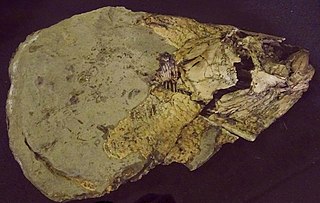 W
WBachea is an extinct genus of ray-finned fish that lived during the Late Cretaceous in what is now central Colombia, South America. The type species is B. huilensis, described in 1997 by María Páramo from the Turonian of Huila, Colombia.
 W
WBelonostomus or Diphyodus is a genus of prehistoric ray-finned fish that was described by Louis Agassiz in 1844. Fossils range from 99.6 million years ago to 66 million years ago.
 W
WBrannerion is an extinct genus of prehistoric bonefish. Fossils of the genus were found in the Romualdo Formation of the Santana Group, Araripe Basin, northeastern Brazil.
 W
WCalamopleurus is an extinct genus of bowfins, comprising three species: C. cylindricus and C. mawsoni from Brazil and C. africanus from Africa.
 W
WCarcharodon hubbelli, also known as Hubbell's white shark, is an extinct species of white shark that evolved between 8 to 5 million years ago during the Late Miocene to Early Pliocene epochs. The shark is a transitional species, showing intermediate features between present-day great white sharks and smaller, prehistoric mako sharks.
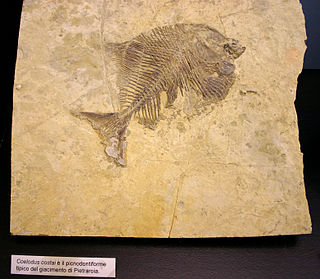 W
WCoelodus is an extinct genus of pycnodontiform fish from the Late Jurassic to early Paleocene (Danian). Fossils of the genus have been found in:JurassicGardies, FranceCretaceousYacoraite Formation, Argentina El Molino Formation, Bolivia Baharîje Formation, Egypt Ahlen and Bückeberg Formations, Germany Nimar Formation, India Alburni, Italy Damergou, Zinder, Niger Cochirleni Formation, Romania La Huérguina and Cabana Formations, Spain Pierre Shale, Kansas Tunbridge Wells Sand Formation, England Tucumcari Formation, New Mexico Twin Mountains and Paluxy Formations, TexasPaleoceneTremp Formation, Spain
 W
WDastilbe is an extinct genus of prehistoric bony fish from the Aptian.
 W
WEnchodus is an extinct genus of aulopiform ray-finned fish related to lancetfish and lizardfish. Species of Enchodus flourished during the Late Cretaceous, and survived the Cretaceous–Paleogene extinction event, persisting into the late Eocene.
 W
WGasteroclupea is a genus of prehistoric clupeiform fish that is related to modern anchovies and herrings. Its fossils date back to the Maastrichtian stage of the Late Cretaceous period. Fossils of the genus have been found in the Yacoraite Formation of Argentina and the El Molino Formation of Bolivia.
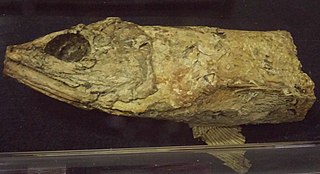 W
WGoulmimichthys is an extinct genus of ray-finned fishes in the order Elopiformes. The genus, first described by Cavin in 1995, is known from various Turonian age formations. The type species G. arambourgi from the Akrabou Formation in the El Rachidia Province of Morocco, and other fossils described are G. gasparini of the La Frontera Formation, Colombia, and G. roberti from the Agua Nueva Formation of Mexico.
 W
WHoloptychius is an extinct genus of porolepiform lobe-finned fish from the Middle Devonian to Carboniferous (Mississippian) periods. It is known from fossils worldwide. The genus was first described by Louis Agassiz in 1839.
 W
WHybodus is an extinct genus of Chondrichthyans. First appearing towards the end of the Permian period, and disappearing during the Late Cretaceous, during the Triassic, Jurassic, and Cretaceous periods the hybodonts were especially successful and could be found in shallow seas across the world. For reasons that are not fully understood, the hybodonts became extinct near the end of the Late Cretaceous period.
 W
WLeedsichthys is a giant member of the Pachycormidae, an extinct group of Mesozoic ray-finned fish that lived in the oceans of the Middle Jurassic period. It is the largest ray-finned fish known to have existed.
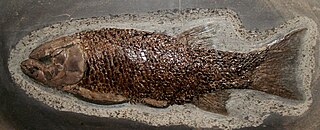 W
WLepidotes is an extinct genus of semionotid neopterygian ray-finned fish from the Jurassic period and Early Cretaceous. Fossils have been found in marine sediments of France, England, and Germany, and in Early Cretaceous sediments of Brazil and Bornholm, Denmark. Isolated scales from the Bahariya Formation have been attributed to Lepidotes. In 1895, many species were assigned to it by Arthur Smith Woodward. They include, L. elvensis, L. semiserratus, L. tuberculatus, L. gallineki, L. leedsi, L. latifrons, L. haydeni, L. occidentalis, L. macrocheirus, L. subovatus, L. minor, L. affinis, L. unguiculatus, L. laevis, L. maximus, L. mantelli, L. degenhardti, L. hauchecorni, L. mawsoni, L. notopterus and L.? pustulatus. Numerous additional species have been assigned to it which Woodward considered indistinguishable from others. It has been considered a wastebasket taxon, characterised by "general features, such as thick rhomboid scales and, for most of the species, by semi-tritorial or strongly tritorial dentition."
 W
WLeptolepis is an extinct genus of teleost fish that lived in freshwater and marine environments from the Middle Triassic period until the Early Cretaceous. The genus is one of the earliest recognized teleost genera.
 W
WMawsonia is an extinct genus of prehistoric coelacanth fish, and the largest of this group, ranging from an estimated 3.5 metres up to 6.3 metres long. It lived during the Cretaceous period. Fossils have been found in the Bahia Group, Romualdo, Alcântara and Missão Velha Formations of Brazil, South America, as well as the Continental Intercalaire of Algeria and Tunisia, the Ain el Guettar Formation of Tunisia, and the Babouri Figuil Basin of Cameroon, Africa. Mawsonia was first described by British palaeontology Arthur Smith Woodward in 1907. The type species is Mawsonia gigas, named and described in 1907. Numerous distinct species have been described since then. M. brasiliensis, M. libyca, M. minor, and M. ubangiensis have all been proposed to be synonyms of M. gigas, although Léo Fragoso's 2014 thesis on mawsoniids finds M. brasiliensis valid and cautions against synonymizing M. minor without further examination. Several recent publications consider M. brasiliensis to be valid as well. Although initially considered to belong to this genus, "Mawsonia" lavocati is most likely referable to Axelrodichthys instead.
 W
WMegalolamna is an extinct genus of lamniform shark that belongs to the family Otodontidae. Its name comes from the similarity of its teeth to those of the extant shark genus Lamna. It is known from the early Miocene Chilcatay Formation of Peru, Oi and O'oshimojo Formations of Japan, and the Jewett Sand Formation of California and Pungo River Formation, North Carolina in the United States, implying a cosmopolitan distribution. It is considered to be the sister genus of Otodus. The study of Megalolamna's taxonomic relationships also demonstrates the possibility that Otodus needs to include the species sometimes assigned to Carcharocles in order to be monophyletic.
 W
WThe moonfish of the genus Mene, the sole extant genus of the family Menidae, are disk-shaped fish which bear a vague resemblance to gourami, thanks to their thread-like pelvic fins. Today, the genus is represented only by Mene maculata of the Indo-Pacific, where it is a popular food fish, especially in the Philippines, where it is known as bilong-bilong, chabita, hiwas or tahas.
 W
WMene purdyi an extinct species of ray-finned fish in the genus Mene, from Late Thanetian-aged marine deposits in northern Peru. M. purdyi is currently known only from a single skull and a few post-cranial bones. M. purdyi is among the largest, if not the largest, members of the genus, as the skull suggests that it would have been over 40 centimetres (16 in) in life. The living species, M. maculata, by comparison, grows to an average length of 18 centimetres (7.1 in).
 W
WOtodus chubutensis, meaning "ear-shaped tooth of Chubut", from Ancient Greek ὠτ and ὀδούς – thus, "ear-shaped tooth", is an extinct species of prehistoric megatoothed sharks in the genus Otodus, that lived during Oligocene, Miocene, and Pliocene epochs, approximately 28 – 5 million years ago. This shark is considered to be a close relative of the famous prehistoric megatoothed shark, O. megalodon. However, as is the case with O. megalodon, the classification of this species is disputed.
 W
WPachyrhizodus is an extinct genus of ray-finned fish that lived during the Late Cretaceous in the Western Interior Seaway in North America and in Colombia, South America. The type species is P. basalis. The species P. etayoi, described in 1997 by María Páramo from the La Frontera Formation in Colombia, was named honouring Colombian geologist and paleontologist Fernando Etayo.
 W
WParahelicoprion is an extinct genus of shark-like eugeneodontid holocephalids from the Permian of the Ural Mountains and Copacabana Formation, Bolivia. The genus name, from "nearly coiled saw" in Greek, directly refers to Helicoprion, a related holocephalid that shares similar traits to it, including the helical whorl of teeth.
 W
WPhareodus is a genus of freshwater fish from the Paleocene to the Eocene of Australia, Europe and North and South America.
 W
WRhacolepis is an extinct genus of ray-finned fish from the Cretaceous Santana Formation of Brazil. Complete fossilised hearts from this species have been recovered.
 W
WSacabambaspis is an extinct genus of jawless fish that lived in the Ordovician period. Sacabambaspis lived in shallow waters on the continental margins of Gondwana. It is the best known arandaspid with many specimens. It is related to Arandaspis.
 W
WSphenacanthus is an extinct genus of a chondrichtyan xenacanthiform that belongs to the Sphenacanthidae family and lived from the Late Devonian, through Carboniferous until the Late Permian period in Scotland, Spain, Russia and Brazil. It lived 359 million years ago, and probably it was one of the first member of the elasmobranchians, the lineage that leads to the modern sharks. Sphenacanthus probably hunts small fishes and, unlike their modern-day relatives, its inhabited fresh water lagoons. Sphenacanthus had seven fins, two in the upper part and five in the underside, and it have a heterodont dentition and mandibles relatively long and deeper. Sphenacanthus serrulatus is still only known from incomplete neurocranial remains and associated dermal material. These suggest that it was a relatively large shark,probably well over one meter in length when fully grown. Its body form was probably similar to that of other phalacanthous sharks.
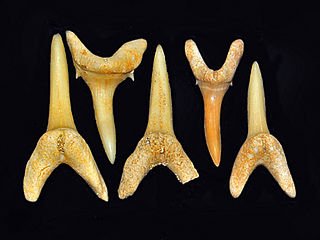 W
WStriatolamia is an extinct genus of sharks belonging to the family Odontaspididae. These extinct sharks lived from the Early Paleocene to Late Miocene.
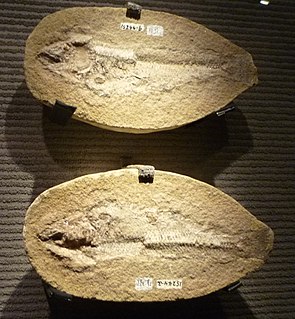 W
WTharrhias is an extinct genus of prehistoric bony fish that lived during the Aptian stage of the Early Cretaceous epoch. The type species T. araripis is named after the Araripe Basin, in which it was found in sediments of the Santana Formation.
 W
WTriodus is an extinct genus of xenacanthidan shark that lived from the Carboniferous to the Triassic. It was a freshwater shark, and fossils have been found in the Chinle Formation and Black Prince Limestone of Arizona, the Petrified Forest Member of New Mexico and the Tecovas Formation of Texas, United States. In 2017, a new species Triodus richterae was described from the Rio do Rasto Formation of Brazil.
 W
WVarasichthys is an extinct genus of prehistoric bony fish that lived during the Oxfordian stage of the Late Jurassic epoch. Fossils have been found in the Domeyko Range of Antofagasta Region, northern Chile. The genus has been compared with other South American fishes as Luisiella and Protoclupea.
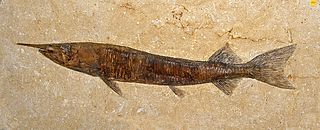 W
WVinctifer is an extinct genus of prehistoric bony fish erected by David Starr Jordan in 1919.
 W
WXenacanthus is a genus of prehistoric sharks. The first species of the genus lived in the later Devonian period, and they survived until the end of the Triassic, 202 million years ago. Fossils of various species have been found worldwide.
 W
WXiphactinus is an extinct genus of large predatory marine bony fish that lived during the Late Cretaceous. When alive, the fish would have resembled a gargantuan, fanged tarpon. The species Portheus molossus described by Cope is a junior synonym of X. audax. Skeletal remains of Xiphactinus have come from the Carlile Shale and Greenhorn Limestone of Kansas, and Cretaceous formations all over the East Coast in the United States, as well as Europe, Australia, the Kanguk and Ashville Formations of Canada,, La Luna Formation of Venezuela and the Salamanca Formation in Argentina.
 W
WXiphiorhynchus is an extinct genus of prehistoric swordfish that lived from the Eocene until the Miocene. Unlike the modern swordfish, both the upper and lower jaws of Xiphiorhynchus were extended into blade-like points.